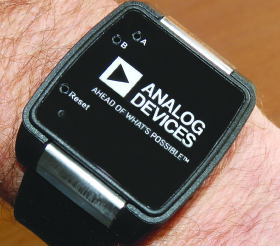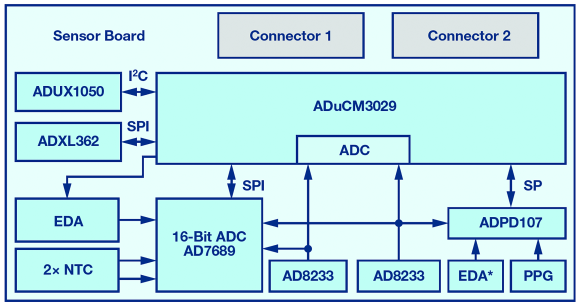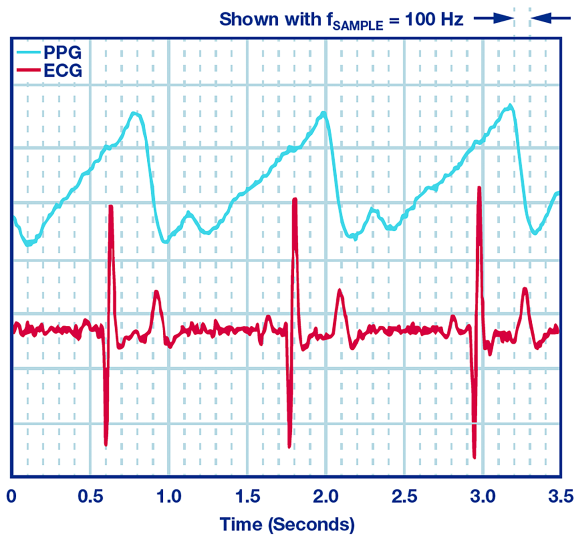

In general, it is not just about exercising more or better nutritional intake – there is more interest in monitoring certain vital body parameters. This is the reason why companies in the smart watch and health watch business have seen their revenue grow over the last few years.
Buying a health watch and measuring body parameters does not mean that you are living healthier. The trick to healthy living is that you’re monitoring certain body parameters over a long period of time to get more familiar with these numbers and use them to adapt your day-to-day life for better health. This is a process that can help you to understand better how the body works and how to reduce the cost of health over the long term.
Although Analog Devices is not a manufacturer of finished products, it has developed a wearable VSM platform to serve as a reference to help the electronic designer and system architect speed up the development process while designing newer, smarter and more accurate wearable devices for the professional and medical market.
What, how, and where we are measuring
A broad range of vital parameters can be measured with a wearable device. Depending on the overall objective, certain specifications are more important to measure than others. The location of the wearable device on the body has a big impact on what can be measured and what cannot. The most obvious location is the wrist. We are accustomed to wearing a device on our wrist, which is the reason why so many products like smart watches and wrist-worn devices are on the market. Besides measuring on the wrist, the head is another good location for wearables.
For example, headphones and earbuds are offered in different styles containing embedded sensors to measure parameters such as heart rate, oxygen saturation and temperature. A third good location for wearables on the body is the chest. First-generation heart rate monitors were designed around a chest strap and this biopotential measurement principle is still a very accurate technique. Today we tend to prefer a chest patch, as the strap is not very comfortable to wear. Several manufacturers are involved in the design of smart patches to monitor vital parameters.
Depending on body location, we are not just faced with the choice of which parameters can be measured, but also what technology should be used. For heart rate measurement, biopotential measurement is one of the oldest technologies. The signals are strong and easy to retrieve from the body by utilising two or more electrodes.
For this approach, integration of the circuitry in a chest strap or headphones is perfect. However, measuring biopotential signals at a single point like the wrist is nearly impossible. You need to measure across the heart where these electric signals are being generated.
For single-spot measurement, optical technology is more appropriate. Light is sent into the tissue and its reflection as a result of blood flow in the arteries is captured and measured. From this optically received signal, beat-to-beat information can be retrieved. This technology sounds rather straightforward, however there are several challenges and influencers that can make the design really difficult, such as motion and ambient light.
Analog Devices’ GEN II wearable device reference platform has most of the previously described technologies on board. The device is designed to wear on the wrist, although you can also remove the soft belt and attach the device to the body to use it as a smart patch. It includes technology to support biopotential measurement, optical heart rate measurement, bioimpedance measurement, motion tracking and temperature measurement, all integrated in a tiny, battery-operated device.

The overall objective
Why did Analog Devices design a system like the GEN II watch? The goal for a system like this is to be able to measure, in an easy way, several vital parameters on the body. The device can simultaneously measure the parameters and store the results on an SD card, or send them over a BLE wireless connection to a smart device. Since the measurements are done simultaneously, it also can help to find correlation among the several measurements.
Biomedical engineers, algorithm providers and entrepreneurs are continuously looking for new technologies, applications and use cases to detect diseases at an earlier stage, in order to minimise negative effects or damage to the body that might occur in the later stages.
A single measurement doesn’t say anything
The new wearable system from Analog Devices is a unique device due to the combination of embedded sensors, processing power and wireless communication.
The optical system is built around the ADPD107 optical analog front end. It makes use of green LEDs to measure PPG and heart rate, while an infrared LED is integrated for proximity to detect when the device is attached to the human body.
Biopotential ECG measurement is supported by two individual AD8233 analog front ends. One front end interfaces to the electrodes embedded in the device. One electrode at the backside of the device is touching one limb and a second electrode at the top of the device can be touched by the other limb (hand) to close the loop.
A second analog front end can be enabled to measure ECG with an external electrode. This allows the user to wear the device like a smart patch and connect the external electrodes directly to the chest. The electrodes at the back side of the device have a double function: in addition to ECG measurement, these can also be used for electrodermal activity (EDA).
EDA, or galvanic skin response (GSR), is related to the conductivity of the skin, which can change due to emotion, coming from either an internal or external stimulus. The GEN II watch is able to detect this minute change in conductivity. The circuit around this measurement principle, including the transmit- and receive-signal chain, is completely built with discrete components. It delivers a high level of accuracy at minimum power dissipation.
Last but not least, a temperature sensor for skin temperature measurement and a three-axis ultra-low-power MEMS sensor (ADXL362) have been integrated. The MEMS sensor tracks motion; this can be used for motion profiling, but also artefacts due to motion can be compensated within the other measurements.
Motion is always an important aspect, eince several vital parameters including heart rate, SPO2 or respiration rate are very dependent on activity, and so motion of the body must be measured. A heart rate of 140 bpm is fine while you are jogging, but you might have to worry if it is 140 bpm while you are sitting on the couch. By combining various sensor signals, new applications can also be supported.
The ultra-low-power ADuCM3029 has been integrated to collect the sensor data and to run the algorithms. Figure 2 gives an overview of the integrated devices on the sensor board.

Stress and continuous blood pressure
For heart rate, either ECG or PPG measurement is needed, so this doesn’t require the combination of sensor outputs, unless we want to compensate for artefacts coming from motion. Use cases where multiple measurements are needed include stress management or continuous blood pressure monitoring.
The emotional state can be measured by monitoring changes in skin conductance. This is just one parameter, but if we are going to combine this with monitoring other parameters, such as heart rate and heart rate variability (HRV), the value of the measurement increases a lot. Skin temperature could also be included as an additional input in measuring stress.
Blood pressure monitoring is another interesting use-case. This is a very important parameter – thankfully most of the systems are cuff-based, which is hard to integrate in a wearable and continuous system. However, there are certain techniques that can be used to measure blood pressure without the need for a cuff.
One technology does this by making use of the pulse wave transmit time (PTT). The arterial PTT signal can be measured between the moment of contraction of the heart on the R-wave and the pulse arrival time in the finger. This transmit time has a direct correlation with blood pressure. Figure 3 shows a measurement of ECG in combination with PPG. The watch can be used for this measurement as it supports ECG and PPG measurement all in one device.
Prototype to product
The GEN II watch has many high-performance sensors and features embedded in a small wearable device. Besides the electronic design, many mechanical aspects have also been taken into consideration. This makes the platform very attractive to design companies and device manufacturers that are focusing on the semi-professional and professional sports markets, as well as on the medical market.
Several parameters can be measured simultaneously – however, algorithms need to complement the application and support the use-cases. This device can give developers and device manufacturers a quick start on the development process, cutting out the need to validate algorithms and build before testing.
The GEN II watch is available in limited quantities and Analog Devices is interested in working with design companies and algorithm providers to develop a state-of-the-art system that can be sold to the professional caregivers and health insurance companies. Some features already meet medical specifications while others still need improvement, but we are definitely on the right track.
For more information contact Conrad Coetzee, Altron Arrow, +27 11 923 9600, [email protected]
| Tel: | +27 11 923 9600 |
| Email: | [email protected] |
| www: | www.altronarrow.com |
| Articles: | More information and articles about Altron Arrow |

© Technews Publishing (Pty) Ltd | All Rights Reserved